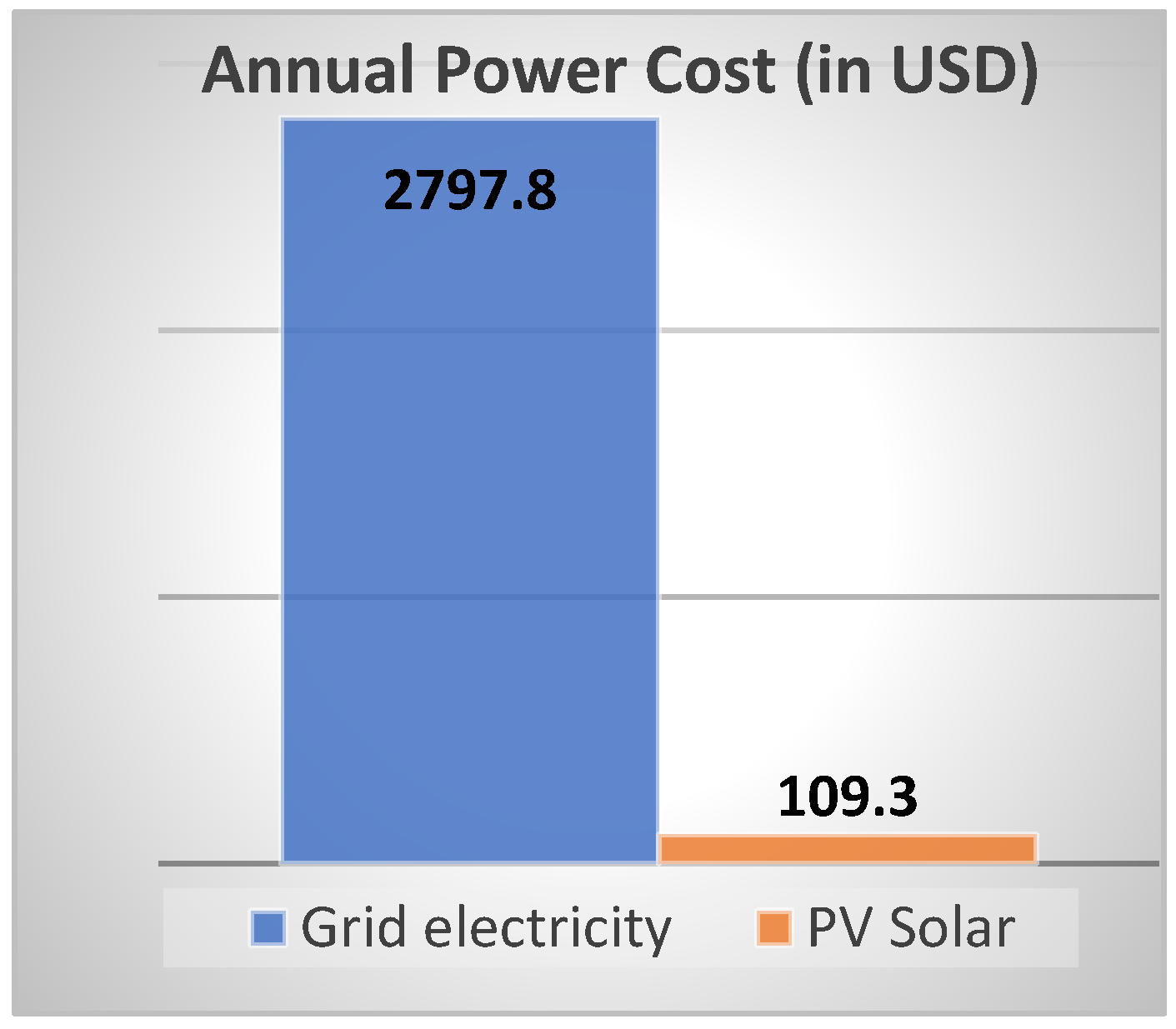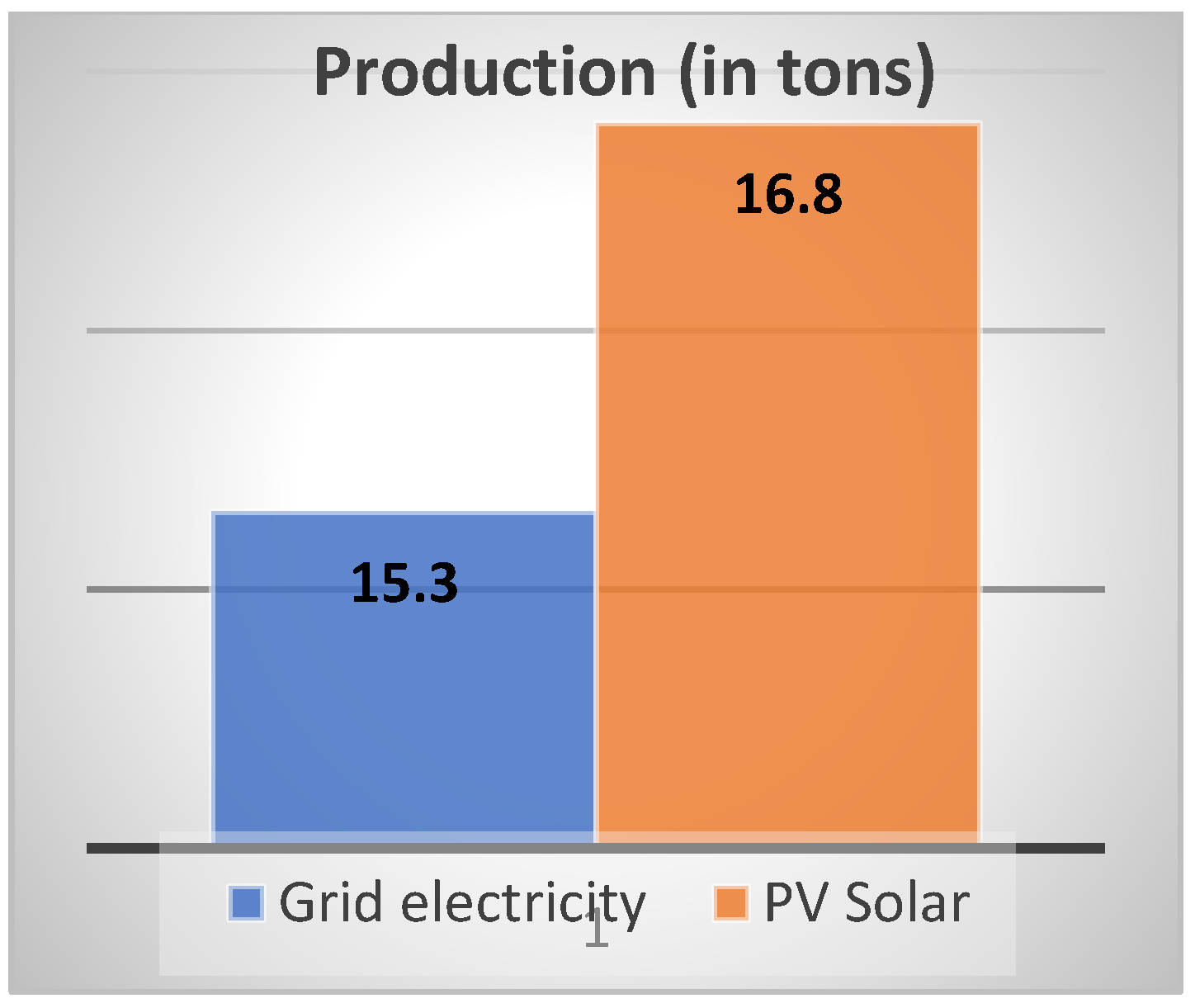Cost–Benefit Analysis of Solar Photovoltaic Energy System in Agriculture Sector of Quetta, Pakistan †
Abstract
1. Introduction
2. Materials and Methods
3. Results and Discussion
3.1. Annual Power Costs and Production Differences
3.2. Cost–Benefit Analysis
3.2.1. Benefit–Cost Ratio for Grid Electricity
3.2.2. Benefit–Cost Ratio for PV Solar System
4. Conclusions and Recommendations
Author Contributions
Funding
Institutional Review Board Statement
Informed Consent Statement
Data Availability Statement
Acknowledgments
Conflicts of Interest
References
- Irfan, M.; Zhao, Z.Y.; Ahmad, M.; Mukeshimana, M.C. Solar energy development in Pakistan: Barriers and policy recommendations. Sustainability 2019, 11, 1206. [Google Scholar] [CrossRef]
- Abbasi, K.R.; Abbas, J.; Tufail, M. Revisiting electricity consumption, price, and real GDP: A modified sectoral level analysis from Pakistan. Energy Policy 2021, 149, 112087. [Google Scholar] [CrossRef]
- Yaqoob, H.; Teoh, Y.H.; Din, Z.U.; Sabah, N.U.; Jamil, M.A.; Mujtaba, M.; Abid, A. The potential of sustainable biogas production from biomass waste for power generation in Pakistan. J. Clean. Prod. 2021, 307, 127250. [Google Scholar] [CrossRef]
- Shah, S.A.A.; Solangi, Y.A. A sustainable solution for electricity crisis in Pakistan: Opportunities, barriers, and policy implications for 100% renewable energy. Environ. Sci. Pollut. Res. 2019, 26, 29687–29703. [Google Scholar] [CrossRef] [PubMed]
- Wakeel, M.; Chen, B.; Jahangir, S. Overview of energy portfolio in Pakistan. Energy Procedia 2016, 88, 71–75. [Google Scholar] [CrossRef]
- Solangi, Y.A.; Shah, S.A.A.; Zameer, H.; Ikram, M.; Saracoglu, B.O. Assessing the solar PV power project site selection in Pakistan: Based on AHP-fuzzy VIKOR approach. Environ. Sci. Pollut. Res. 2019, 26, 30286–30302. [Google Scholar] [CrossRef] [PubMed]
- Shah, S.A.A.; Valasai, G.D.; Memon, A.A.; Laghari, A.N.; Jalbani, N.B.; Strait, J.L. Techno-economic analysis of solar pv electricity supply to rural areas of Balochistan, Pakistan. Energies 2018, 11, 1777. [Google Scholar] [CrossRef]
- Ali, M.A.; Yamin, M.; Arslan, C.; Farid, U.; Nasir, A. A Feasibility Study: Off-Grid Photovoltaic Solar Power Supply to the Remote Areas of Pakistan. Pak. J. Agri. Sci. 2020, 57, 1313–1316. [Google Scholar]
- Kakar, M.Z.K.; Harijan, K.; Kumar, L. Load Assessment of Solar PV System: Case Study of Tor Tang Village of Baluchistan. Int. J. Renew. Energy Resour. 2018, 8, 29–35. [Google Scholar]
- O'Mahony, T. Cost-Benefit Analysis and the environment: The time horizon is of the essence. Environ. Impact Assess. Rev. 2021, 89, 106587. [Google Scholar] [CrossRef]
- Waheed, A. To Electrify a Flood Affected Village in Sajawal, Pakistan by Utilizing the Available Renewable Energy Resources. Available online: http://urn.kb.se/resolve?urn=urn:nbn:se:kth:diva-149865 (accessed on 20 September 2022).


| Cost Details | Particulars | Cost (in USD) |
|---|---|---|
| Initial cost | HT (structure) 46′ | 619.4 |
| LT (structure) 30′8″ | 162.3 | |
| 25 KVA11/4 KV transformer | 859.7 | |
| Static energy meter 3 phase | 19.2 | |
| AAC ANT (1/172) | 298.4 | |
| 11kv steel cross arm | 25.6 | |
| 11 kv D/Out C/Out insulator | 24.7 | |
| Connection cable | P.V.C 7/058 I/Core (10 mm2) | 311.0 |
| Submersible | 20 hp | 1220.0 |
| Pipe | 40 (20 ft each) | 1376.5 |
| Carriage | Not applicable | 21.6 |
| Annual O and M | 12 months | 2797.8 |
| Other expenses | Not applicable | 109.2 |
| Total | 7845.4 | |
| Cost Details | Particulars | Costs (in USD) |
|---|---|---|
| Initial cost | Solar panels 300 W (65) | 6134.0 |
| DC inverter | 959.1 | |
| Connection cable | 83.8 | |
| Frames | 1629.3 | |
| Submersible | 20 hp | 1220.0 |
| Pipe | 40 (20 ft each) | 1376.5 |
| Carriage | Not applicable | 21.6 |
| Annual O and M | 12 months | 26.6 |
| Other expenses | Not applicable | 109.2 |
| Total | 11,560.3 | |
Disclaimer/Publisher’s Note: The statements, opinions and data contained in all publications are solely those of the individual author(s) and contributor(s) and not of MDPI and/or the editor(s). MDPI and/or the editor(s) disclaim responsibility for any injury to people or property resulting from any ideas, methods, instructions or products referred to in the content. |
© 2022 by the authors. Licensee MDPI, Basel, Switzerland. This article is an open access article distributed under the terms and conditions of the Creative Commons Attribution (CC BY) license (https://creativecommons.org/licenses/by/4.0/).
Share and Cite
Mustafa, Z.; Iqbal, R.; Siraj, M.; Hussain, I. Cost–Benefit Analysis of Solar Photovoltaic Energy System in Agriculture Sector of Quetta, Pakistan. Environ. Sci. Proc. 2022, 23, 26. https://doi.org/10.3390/environsciproc2022023026
Mustafa Z, Iqbal R, Siraj M, Hussain I. Cost–Benefit Analysis of Solar Photovoltaic Energy System in Agriculture Sector of Quetta, Pakistan. Environmental Sciences Proceedings. 2022; 23(1):26. https://doi.org/10.3390/environsciproc2022023026
Chicago/Turabian StyleMustafa, Zaid, Rashid Iqbal, Mahwish Siraj, and Iqbal Hussain. 2022. "Cost–Benefit Analysis of Solar Photovoltaic Energy System in Agriculture Sector of Quetta, Pakistan" Environmental Sciences Proceedings 23, no. 1: 26. https://doi.org/10.3390/environsciproc2022023026
APA StyleMustafa, Z., Iqbal, R., Siraj, M., & Hussain, I. (2022). Cost–Benefit Analysis of Solar Photovoltaic Energy System in Agriculture Sector of Quetta, Pakistan. Environmental Sciences Proceedings, 23(1), 26. https://doi.org/10.3390/environsciproc2022023026






